Crystal Structures of Ethyl 4-(4-Florophenyl)-6-phenyl-2-substituted-3-pyridinecarboxylates
Abstract
Three substituted pyridinecarboxylates were synthesized; (I) ethyl 2-bromo-4-4(fluorophenyl)-6-phenyl-3-pyridinecarboxylate, C20H15BrFNO2, (II) ethyl 4-(4-fluorophenyl)-2-(4-morpholinyl)-6-phenyl-3-pyridinecarboxylate, C24H23FN2O3, and (III) ethyl 4-(4-fluorophenyl)-6-phenyl-2-(1-piperidinyl)-3-pyridinecarboxylate, C25H25FN2O2. It was found that compound (I) belongs to the orthorhombic system with space group P212121, compound (II) to the monoclinic system with space group P21/c, and compound (III) to the monoclinic system with space group C2/c. The morpholine ring in (II) and piperidine ring in (III) have the shape of the distorted chair configuration.
1. Introduction
Nicotinate (3-pyridinecarboxylate) esters represent an important class of heterocyclic compounds characterized by highly pronounced pharmacological and biological importance. Many publications have reported on numerous activities of various 3-pyridinecarboxylate esters as agrochemical fungicides [1, 2], herbicides [3, 4], A3 adenosine receptor antagonists [5], cholesteryl ester transfer protein inhibitors [6], blood circulation promoters, and anti-inflammatory agents [7, 8]. Pharmacological compositions containing nicotinate esters have been, also, appeared for using as antidandruff, anti-itching, and hair loss preventing [9, 10].
2. Materials and Methods
2.1. Synthesis
2.1.1. Ethyl 2-Bromo-4-(4-fluorophenyl)-6-phenyl-3-pyridinecarboxylate (I)
To a solution of ethyl 4-benzoyl-3-(4-fluorophenyl)-2-cyanobutyrate (10 mmol) in glacial acetic acid (20 mL), heated at 60–70°C, a solution of bromine (11 mmol) in glacial acetic acid (5 mL) was added dropwise while stirring, at such a rate maintaining the same temperature (15 min.). After complete addition, stirring was continued for 3 h at the same temperature. Then, the reaction mixture was stored at room temperature (25–30°C) overnight and poured into ice-cold water (200 mL). So, the separated solid was collected, washed with water, and crystallized from ethanol giving the corresponding compound (I) as colourless crystals. Reaction time 40 h; m.p. 134–136°C; yield 0.8 g (79%). Anal. for C20H15BrFNO2 (400.24): calcd. C 60.01, H 3.78, and N 3.50; found: C 60.22, H 3.70, and N 3.47, Figure 1.
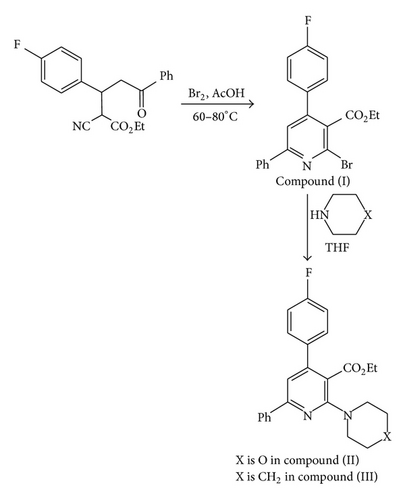
2.1.2. Ethyl-4-(4-fluorophenyl)-2-(4-morpholinyl)-6-phenyl-3-pyridinecarboxylate (II)
A mixture of (I) (2.5 mmol) and the corresponding secondary amine (10 mmol) in tetrahydrofuran (20 mL) was boiled under reflux for the appropriate time. The clear reaction mixture was evaporated till dryness under reduced pressure and the residue was triturated with methanol (5 mL) affording the corresponding compound (II), Figure 1. So, the separated solid was collected and crystallized as colourless crystals from light petroleum (60–80°C). Reaction time 40 h; m.p. 134–136°C; yield 0.8 g (79%). Anal. for C24H23FN2O3 (406.44): calcd. C 70.92, H 5.70, and N 6.89; found: C 70.90, H 5.66, and N 6.94.
2.1.3. Ethyl-4-(4-fluorophenyl)-6-phenyl-2-(1-piperidinyl)-3-pyridinecarboxylate (III)
Also, a mixture of (I) (2.5 mmol) and the corresponding secondary amine (10 mmol) in tetrahydrofuran (20 mL) was boiled under reflux for the appropriate time. The mixture was evaporated till dryness under reduced pressure and the residue was triturated with methanol (5 mL) affording the corresponding compound (III), Figure 1. So, the separated solid was collected and crystallized as colourless crystals from light petroleum (60–80°C). Reaction time 45 h; m.p. 104–106°C; yield 0.8 g (79%). Anal. for C25H25FN2O2 (404.47): calcd. C 74.23, H 6.23, and N 6.93; found: C 74.31, H 6.37, and N 7.02.
2.2. X-Ray Single Crystal Diffraction
The crystals were examined under the microscope to check for imperfections and, then, mounted onto thin glass fibers glued with epoxy glue. The selected crystals were mounted on an Enraf-Nonius 590 Kappa CCD single crystal diffractometer at National Research Center of Egypt [11]. X-ray diffraction data were collected at room temperature with graphite monochromated Mo-Kα (λ = 0.71073 Å) radiation [12]. Refinement and data reduction were carried using Denzo and Scalepack programs [13]. The crystal structures were solved by direct method using SIR92 program [14] which revealed the positions of all nonhydrogen atoms and refined by the full matrix least squares refinement based on F² using maXus package [15]. The anisotropic displacement parameters of all nonhydrogen atoms were refined; then, the hydrogen atoms were introduced as a riding model with C-H = 0.96 Å and refined isotropically. The molecular graphics were prepared using ORTEP [16] program.
3. Results and Discussion
In the present study three structures have been solved, namely, ethyl 2-bromo-4-4(fluorphenyl)-6-phenyl-3-pyridinecarboxylate (I), ethyl 4-(4-fluorophenyl)-2-(4-morpholinyl)-6-phenyl-3-pyridinecarboxylate (II) and ethyl 4-(4-fluorophenyl)-6-phenyl-2-(1-piperidinyl)-3-pyridinecarboxylate (III). The basic unit of these compounds consists mainly of pyridine ring (A), fluorphenyl ring (B), phenyl ring (C), and carboxylate group. They differ only in the attachment at the position (C2) of the pyridine ring, where (I) has Br atom, Figure 2, (II) has morpholine ring (D), Figure 3, and (III) has piperidine ring (D), Figure 4. Compound (I) belongs to the orthorhombic system with space group P212121 and (II) to monoclinic system with space group P21/c. Compound (III) belongs to monoclinic system with space group C2/c. The crystal and experimental data of compounds (I), (II), and (III) are given in Tables 1, 2, and 3, respectively.
| Formula: C20H15BrFNO2 | Formula weight = 400.252 |
| Crystal system: orthorhombic | Dx = 1.523 Mg m−3 |
| Space group: P212121 | λ = 0.71073 |
| a = 8.3696(2) Å | θ = 0.00–26.4° |
| b = 9.1641(2) Å | μ = 2.38 mm−1 |
| c = 22.7594(6) Å | T = 298 K |
| V = 1745.64(7) Å3 | Needle (0.4 × 0.2 × 0.1 mm) |
| 3568 observed reflections | Colourless |
| Rint = 0.034 | Z = 4 |
| Refinement on F2 | θmax = 26.4° |
| Fullmatrix least squares refinement | Criterion: I > 3.00 sigma(I) |
| R(gt) = 0.037 | wR(gt) = 0.021 |
| wR(gt) = 0.021 | Δρmax = 0.76 e/Å3 |
| S(gt) = 0.983 | Δρmin = −0.86 e/Å3 |
| 2236 reflections | Only coordinates of H atoms refined |
| 226 parameters | Calculated weights sigma |
| 0 restraints | (Δ/σmax) = 0.019 |
| Formula: C24H23FN2O3 | Formula weight = 406.457 |
| Crystal system: monoclinic | Dx = 1.265 Mg m−3 |
| Space group: P21/c | λ = 0.71073 |
| a = 11.6756(5) Å | θ = 0.00–26.986° |
| b = 10.0452(5) Å | μ = 0.09 mm−1 |
| c = 18.6293(9) Å | T = 298 K |
| β = 102.379(2)° | Prismatic (0.22 × 0.17 × 0.12 mm) |
| V = 2134.1(2) Å3 | Colourless |
| 3126 observed reflections | Z = 4 |
| Rint = 0.037 | θmax = 26.97° |
| Refinement on F2 | Criterion: I > 3.00 sigma(I) |
| Fullmatrix least squares refinement | |
| R(gt) = 0.045 | Δρmax = 0.46 e/Å3 |
| wR(gt) = 0.092 | Δρmin = −0.28 e/Å3 |
| S(gt) = 1.376 | Only coordinates of H atoms refined |
| 2876 reflections | Calculated weights sigma |
| 271 parameters | (Δ/σmax) = 0.003 |
| 0 restraints |
| Formula: C25H25FN2O2 | Formula weight = 404.485 |
| Crystal system: monoclinic | Dx = 1.237 Mg m−3 |
| Space group: C2/c | λ = 0.71073 |
| a = 20.6853(4) Å | θ = 3.2–25° |
| b = 6.5126(1) Å | μ = 0.08 mm−1 |
| c = 33.8471(7) Å | T = 298 K |
| β = 107.6328(7)° | Prismatic (0.4 × 0.35 × 0.25 mm) |
| V = 4345.49(14) Å3 | Colourless |
| 12521 observed reflections | Z = 8 |
| Rint = 0.033 | θmax = 25° |
| Refinement on F2 | Criterion: I > 3.00 sigma(I) |
| Fullmatrix least squares refinement | |
| R(gt) = 0.047 | Δρmax = 0.37 e/Å3 |
| wR(gt) = 0.111 | Δρmin = −0.34 e/Å3 |
| S(gt) = 1.894 | Only coordinates of H atoms refined |
| 2175 reflections | Calculated weights sigma |
| 271 parameters | (Δ/σmax) = 0.009 |
| 0 restraints |
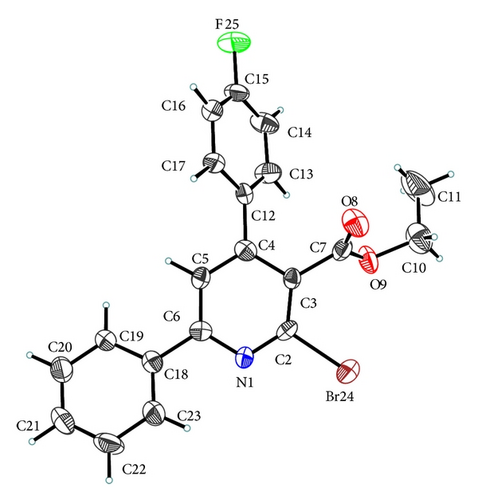
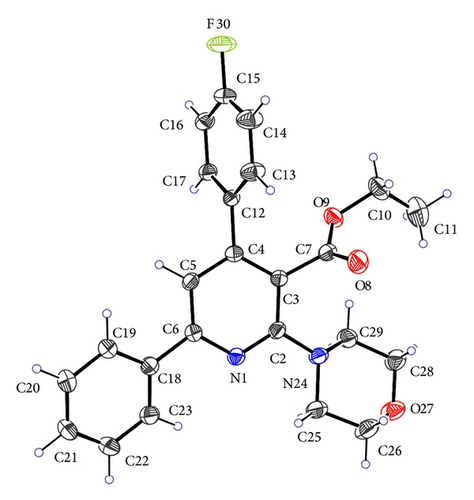
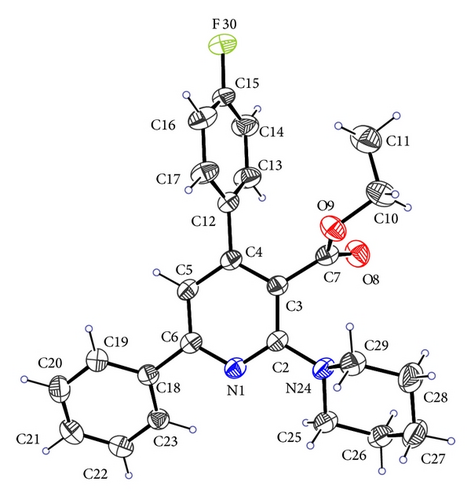
The morpholine ring in (II) and piperidine ring in (III) take the shape of the distorted chair configuration. In ring (A), the lengths of the bond N1–C2 are 1.325(4), 1.327(3), and 1.3323(11) Å for (I), (II), and (III), respectively, suggesting shortened partial double bond. The bond distance C2–C3 in (I) is shorter than the same bond distance in the other compounds, which may be due to the Br effect at C2. The average values of bond lengths of ring (A) agree well with the average values reported for the same ring in other compounds [17]. The average values of bond lengths of ring (B) and ring (C) agree with each other and with the average values of other workers [18].
The longest bond length in ring (D) is C28–C29 = 1.471(4) Å in (II) and C28–C27 = 1.531(2) Å in (III). The shortest bond length in the same ring is C26–O27 = 1.404(4) Å in (II) and N24–C29 = 1.4577(12) Å in (III), with mean values 1.448(4) Å in (II) and 1.4899(16) Å in (III). These values reflect the shortened character of the single bonds of the chair configuration of the morpholine and piperidine rings, which is consistent with the reported values in [19, 20]. The values of the valency angles N1–C2–C3 in ring (A) are 128.1(2), 122.4(2), and 122.20(10)° in the investigated compounds, respectively. These variations may be due to the substitution effect at C2. The decrease in the bond angle less than 120° for the angles C2–N1–C6 (116.3(2), 118.9(2) and 119.21(8)° in (I), (II), and (III), resp.) may be attributed to the nonprotonated ring system. Some selected geometric parameters are given in Table 4.
| I | II | III | |
|---|---|---|---|
| C15–F | 1.358(4) | 1.373(3) | 1.3637(11) |
| C7–C3 | 1.511(4) | 1.494(4) | 1.4990(13) |
| C7–O8 | 1.200(3) | 1.205(3) | 1.1950(11) |
| C7–O9 | 1.316(4) | 1.333(3) | 1.3323(12) |
| Br–C2 | 1.913(3) | ||
| C13–C12–C17 | 119.7(3) | 118.4(2) | 118.13(10) |
| N1–C6–C18 | 115.9(3) | 115.1(2) | 116.10(9) |
| C26–O27–C28 | 109.3(2) | ||
| C26–C27–C28 | 109.6(2) | 109.52(11) | |
From the calculations of the best plane passing through the ring (A) in the three compounds, it was found that the maximum deviation is corresponding to the atoms C3 = 0.0168 Å esd (0.0043) in (I), C3 = 0.0560 Å esd (0.0035) in (II), and C2 = −0.0203 Å esd (0.0018) in (III). The minimum deviation is corresponding to the atoms N1 = −0.0012 Å esd (0.0034), N1 = −0.0076 Å esd (0.0029), and N1 = 0.0013 Å esd (0.0015) in (I), (II), and (III), respectively. These values mean that the ring (A) exhibits planar configuration. Both rings (B) and (C) in the three compounds are planar within themselves with maximum deviation at C17 = −0.0180 Å esd (0.0049) and C21 = 0.0037 Å esd (0.0048) in (I), at C16 = 0.0053 Å esd (0.0040) and C20 = 0.0070 Å esd (0.0046) in (II), and at C15 = −0.0098 Å esd (0.0023) and C23 = 0.0091 Å esd (0.0018) in (III), respectively.
The values of the torsion angles C11–C10–O9–C7 are −87.3(5), 86.5(5), and 96.7(2)° in the three compounds, respectively, describing the orientation of the methyl group with respect to the carboxylate. From these values, it is obvious that ethyl group has the same orientation in (I) and (III) and opposite orientation in (II). Thus, in (I) and (III) the ethyl group oriented towards the ring (B) as indicated from the interatomic distances for compound (III) C28–H11C = 6.261(3), C29–H11C = 5.780(3), O8–H29B = 4.497(2), and O8–H28A = 3.385(2) Å. This is in contrary to compound (II) where the ethyl group is oriented towards the morpholine ring as indicated from the interatomic distances C28–H11C = 3.380(3), C29–H11C = 3.424(3), O8–H29B = 2.953(2), and O8–H28A = 3.386(2) Å.
The small dihedral angles between ring (C) and ring (A) are 15.46° esd (3.442) and 23.15° esd (3.449) in (I) and (II), respectively, which may assist the delocalization of the pyridine ring. The dihedral angles between ring (B) and ring (A) are 53.28° esd (3.429), 111.95° esd (3.396), and 77.24° esd (3.398) in (I), (II), and (III) respectively. Moreover, the torsion angles C3–C4–C12–C13 and C5–C4–C12–C17 are 55.1(5) and 51.3(5)° in (I), −63.6(4) and −67.4(4)° in (II), and 75.0(2) and 77.6(2)° in (III). These variations may be due to the substitution effect at C2. A network of intermolecular contact stabilizes the structure of the three compounds with different symmetry codes in each compound. C–H⋯O in (I), C–H⋯F and C–H⋯O in (II), and C–H⋯O in (III) as given in Tables 5, 6, and 7. The packing diagrams of (I), (II), and (III) are shown in Figures 5, 6, and 7, respectively.
| D–H⋯A | D⋯H (Å) | H⋯A (Å) | D⋯A (Å) | D–H⋯A (°) |
|---|---|---|---|---|
| C5–H5(i)⋯O8 | 0.960(3) | 2.444(2) | 3.381(4) | 165.4(2) |
- (i) − 1/2 + x, 1/2 − y, −z.
| D–H⋯A | D⋯H (Å) | H⋯A (Å) | D⋯A (Å) | D–H⋯A (°) |
|---|---|---|---|---|
| C11–H11A(i)⋯F30 | 0.960(4) | 2.541(2) | 3.468(7) | 163.0(3) |
| C17–H17(ii)⋯O27 | 0.960(3) | 2.510(2) | 3.348(5) | 146.3(2) |
- (i) − 1 − x, −y, −z; (ii) − x, 1/2 + y, 1/2 − z.
| D–H⋯A | D⋯H | H⋯A | D⋯A | D–H⋯A |
|---|---|---|---|---|
| C14–H14(i)⋯O8 | 0.9600(10) | 2.520(8) | 3.479(3) | 175.74(8) |
- (i)1 − x, y, 1/2 − z.
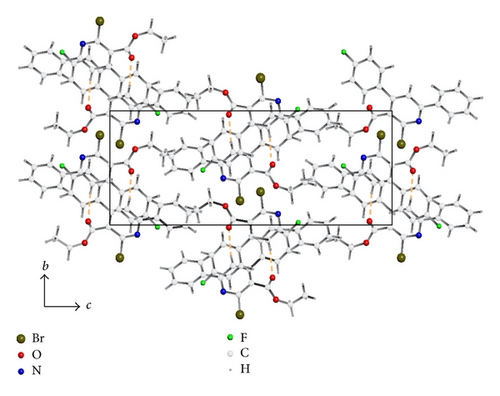
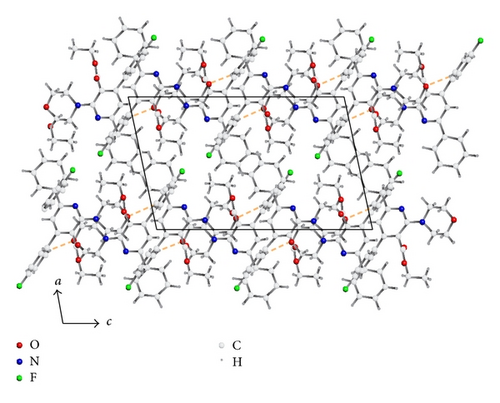
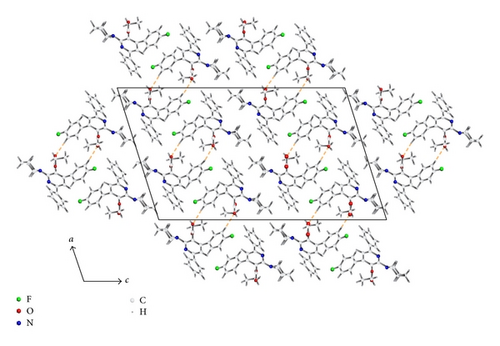
Supplementary full crystallographic information for compounds (I), CCDC 279952, (II), CCDC 265112, and (III), CCDC 265113 can be obtained via http://www.ccdc.cam.ac.uk/conts/retrieving.html or from the Cambridge Crystallographic Data Centre, 12 Union Road, Cambridge, UK.
4. Conclusions
The molecular and crystal structures of three pyridinecarboxylate derivatives have been determined by X-ray single crystal diffraction. Two compounds were found to belong to the monoclinic system and the third was found to belong to the orthorhombic one. The obtained results showed a very good agreement with other reported results for similar compounds.
Conflict of Interests
The authors declare that there is no conflict of interests regarding the publication of this paper.
Acknowledgment
The assistance of the X-ray crystallography team in the National Research Center of Egypt is gratefully acknowledged.




